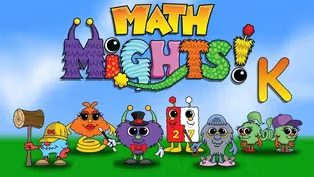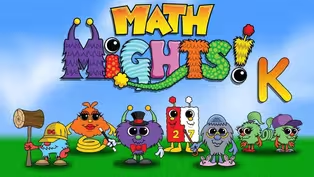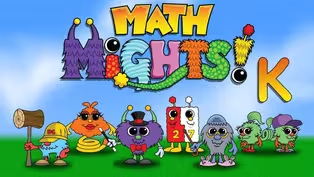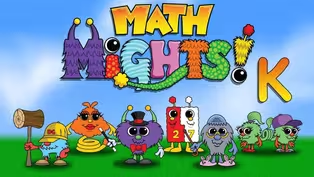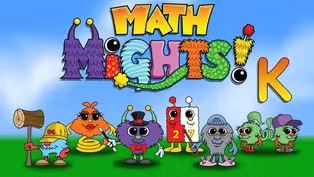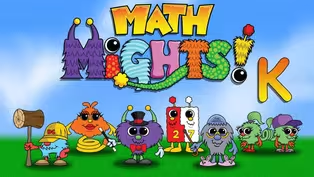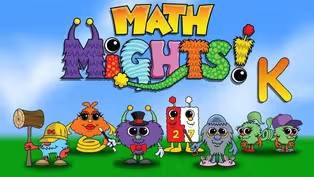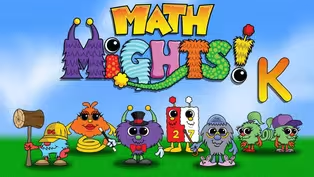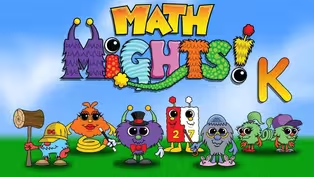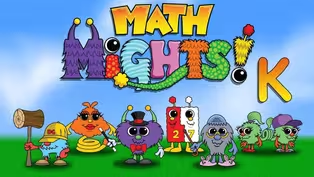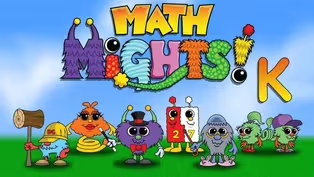Math Mights
2 Parts of Expressions
Season 3 Episode 304 | 15m 59sVideo has Closed Captions
Join Mrs. Gray for a word problem with Professor Barble!
Join Mrs. Gray for a word problem with Professor Barble! Next ready to have some fun with pattern block designs as we match expressions to two parts.
Problems playing video? | Closed Captioning Feedback
Problems playing video? | Closed Captioning Feedback
Math Mights is a local public television program presented by Detroit PBS
Math Mights
2 Parts of Expressions
Season 3 Episode 304 | 15m 59sVideo has Closed Captions
Join Mrs. Gray for a word problem with Professor Barble! Next ready to have some fun with pattern block designs as we match expressions to two parts.
Problems playing video? | Closed Captioning Feedback
How to Watch Math Mights
Math Mights is available to stream on pbs.org and the free PBS App, available on iPhone, Apple TV, Android TV, Android smartphones, Amazon Fire TV, Amazon Fire Tablet, Roku, Samsung Smart TV, and Vizio.
Providing Support for PBS.org
Learn Moreabout PBS online sponsorshipMore from This Collection
Video has Closed Captions
Join Mrs. Gray for a subtraction word problem with Porfessor Barble! (15m 52s)
Video has Closed Captions
Join Mrs. Gray for a subtraction word problem with Porfessor Barble! (15m 59s)
Video has Closed Captions
Join Mrs. Gray for a subtraction word problem with Professor Barble! (15m 59s)
Video has Closed Captions
Join Mrs. Gray for a subtraction word problem with Professor Barble! (15m 59s)
Compose & Decompose Numbers to 9
Video has Closed Captions
Join Mrs. Gray for a word problem with Professor Barble! (16m 1s)
Break apart pattern block designs
Video has Closed Captions
Join Mrs. Gray for a word problem with Professor Barble! (15m 59s)
Video has Closed Captions
Join Mrs. Gray for a word problem with Professor Barble! (15m 59s)
Addition & Subtraction Expressions
Video has Closed Captions
Match fun story problems with the correct addition or subtraction expression. (16m 15s)
Subtraction with Word Problems Part 2
Video has Closed Captions
Join Mrs. Gray & Dotson for a Numeracy Talk with My Counting Buddy Junior! (16m)
Video has Closed Captions
Join Mrs. Gray & Dotson to talk about numbers with My Counting Buddy Junior! (16m)
Addition Word Problems with Quick Draws
Video has Closed Captions
Join Mrs. Gray for Numeracy Talk with Dotson working on conservation to 10. (16m)
Providing Support for PBS.org
Learn Moreabout PBS online sponsorship(playful music) (air whooshing) (playful music) (air swirling) - [Group] Math Mights.
- Hi kindergarten math mights, my name Mrs. Gray, and I can't wait to learn some math with you today.
Today, we're gonna be doing a word problem with our friend professor Barble.
We're also gonna be learning about expressions and the two parts that make expressions.
Get ready.
We're gonna see our friend professor Barble, here he comes now.
(playful music) Professor Barble, he is an adventurer.
He always wears a hat.
This is his thinking cap.
On the top of his thinking cap comes a pole, and on the top of the pole, there are four arrows.
Those arrows help remind professor Barble, that when he comes to a word problem, he needs to stop and think about which way he needs to go in his word problem.
Get ready, professor Barble now has a word problem for us.
We're gonna be doing a problem today about lamps.
Professor Barble likes for us to do our word problem on our kindergarten journal template.
The journal template will help us slow down and see each part of the problem.
Let's first take a look at the whole problem, then we'll go back and add our chunks.
Liv counted the lamps in her house.
She found five lamps in her living room and two lamps in the bedroom.
How many lamps did Liv find?
Now we're gonna say it, and we're gonna chunk the information, and you're gonna try to help me read it to.
Liv counted the lamps in her house.
She found five lamps in her living room.
We're gonna add a chunk there, because we've learned our first piece of information.
Can you read it with me?
Liv counted the lamps in her house.
She found five lamps in her living room.
And she found two lamps in her bedroom.
We're gonna add our second chunk because that's our second piece of information.
Can you say it with me?
She counted two lamps in her bedroom.
How many lamps did Liv find?
That's our third chunk of information.
Let's add it in.
Now, let's look at the sentence form for what we're going to be figuring out.
It says, Liv found hmmm lamps.
Remember, whenever we see that line, we say, hmm.
Because we don't know the answer that we're gonna put there later.
Now we're gonna go to our work mat and we're going to start working out the problem.
Liv found five lamps.
Let's add them on our map.
One, two, three, four, five.
She then found two more lamps in the bedroom.
Add them on the mat.
One, two.
After we do that, let's count them.
Can you count with me?
One, two, three, four, five, six, seven.
Liv found seven lamps.
After we did it on our mat, we're now gonna do our quick draw.
Remember, we're gonna make it quick so we're just gonna draw circles.
She saw the five lamps.
One, two, three, four, five.
She then saw two more, one, two.
After we do the quick draw, we're gonna put it in the 10 frame so we can organize it.
There were five, one, two, three, four, five, and two more.
Now let's try to take it and put it into our number bond to see what Liv saw.
Liv saw five lamps in the living room.
She saw two lamps in the bedroom.
When we take the five and the two and we put them together, we have our seven.
Live saw the seven.
Let's add it in our number bond.
Now let's try to do our expression, 5 + 2 = 7.
We know that this was an addition problem because Liv some more lamps.
She didn't get rid of any.
And because she saw more, it's an addition problem.
Let's do our sentence at the top now.
Liv found hmm lamps.
Well, we know that she found seven.
So we're gonna fill it in on our journal template.
Liv found seven lamps.
Excellent job today on our word problem.
Professor Barble would be so proud that we stopped and we really were thinking about our word problem.
Let's take a look at our I can statement for today.
I can compose and decompose numbers and show two parts with an expression.
I have a picture to show to you today, and on this picture, there are three different boxes.
And in the boxes, there are some dots.
What do you see with the dots?
How many?
How do you see them?
Let's take a closer look with our friends Brianna and Hannah today.
Let's see how Brianna saw it.
Brianna saw six.
Brianna saw three on the top and three on the bottom.
Let's look at what Hannah saw for the next picture.
Hannah saw six as well, but Hannah saw four and two.
Let's take a look at the last group.
Brianna saw six again, but she saw five this time and one more.
Great job Hannah and Brianna.
You came up with some great ways to see those numbers.
What did you notice?
Let's take a look back at those pictures to see what you see.
What is the same?
What is different?
Now we're gonna try to match our number bonds to go along with the different pictures.
When we take out our number bonds.
I have three different number bonds here.
Hmm, I wonder which one matches which picture?
Well, I noticed that each of them have six chips on our number bonds.
We can see that because on each number bond, there are six at the top when we put the numbers together.
Let's look at just the first picture.
The first picture, there were three on the top and three on the bottom.
I think I saw a number bond to go along with that.
Let's find it.
Here it is.
Here is the number bond.
It shows three and three.
When you put them together, it makes that six.
Let's try to find the number bond for the next picture.
The next picture, there was four and two.
Let's look.
Oh, here's our number bond, it shows four and two.
When you put it together, it equal the six.
That means, this must be the number bond for the last one.
Let's check it.
There was five red and one yellow.
Five and one, put them together makes that six.
All of these pictures were the same because each of them had six chips in the picture.
But each picture was broken up differently because each piece of the red and the yellow had different numbers.
But when we took the number for the red and the number for the yellow and put them together, it made the six.
Wow, math mights, you did so good helping me match those number bonds to the picture.
Now we're gonna do some more with matching a drawing to an expression Andre and Lin, just played a game called, "Shake Those Discs".
This is a game where you would have a cup of red and yellow chips, and, you would take the cup and you would shake, shake, shake and you would spill them out.
And based on the color, you would write an expression.
Andre and Lin were able to play the game and write out four different expressions that they saw when they were playing.
Our job now is to create a drawing using the chips that would match the expression.
Let's take a look at the four expressions that they found.
Here, we have the first expression.
It says 0 + 7.
And here is where we're going to do the drawing.
Using our chips, we're going to build it.
So the first number said zero.
That means I'm not going to add any yellow chips, using the first number, that's how many yellow chips I know I'm going to need.
The second number will be my red chips.
There were seven in the first expression, let's build it.
One, two, three, four, five, six, seven.
Let's keep going with the next expression.
They found 2 + 5.
That means, they had two yellow chips, one, two, and they had five red chips.
Let's build it.
One, one, two, three, four, five.
The next expression they found was 4 + 3. using our yellow chips, we're gonna build the four.
One, two, three, four.
The second number was three, that's how many red chips we need.
One, two, three.
The last expression they found during the game, was 6 + 1.
Using the yellow chips, we're gonna build the six.
Let's do it.
One, two, three, four, five, six.
Then they had just one red chip for that expression.
Let's add it on our drawing, one.
Let's take a closer look at all of the expressions.
Did you notice anything that was similar?
Did you see anything that was different?
Let's take a look.
When I look at each of the drawings, I notice they each have seven chips.
All of the expressions added up to seven.
But, they were different, because each of the numbers was broken up into two separate numbers.
Let's take a closer look at what I mean.
For the first one, there was zero and seven, but when you put it together it was still seven.
For the second one, they found that two and five.
When you put two and five together, that also equals seven.
Then they found the four and the three, when they found four and three, put it together, that also equals seven.
And on the last one, they found six and one.
When you put that together, that one also equals seven.
Andre and Lin seemed like they had so much fun.
Now it's our turn to play "Shake Those Discs."
In my cup, I have eight discs.
We're gonna give 'em a shake and we're gonna spill 'em out.
Now we're gonna take this and we're gonna try to organize it.
I'm gonna move all of my red and then all of my yellow together in a line.
Taking a look here, there were three red.
So I'm gonna make a number expression to go along with it as I go.
We're gonna write, three for the three red.
We know that this is gonna be an addition problem because we're putting more chips together.
We're taking the red and the yellow and putting them together.
So I'm gonna add the addition symbol in our number expression.
Three plus, now we have to check how many yellow we spilled.
Can you count them with me?
One, two, three, four, five.
3 + 5 = 8.
Let's go and count them just to be sure.
Make sure you count with me.
One, two, three, four, five, six, seven, eight.
3 + 5 = 8.
I hope you had a great time playing that game.
Now it's your turn to play "Shake Those Discs".
When you play, you are going to be using nine instead of eight.
If you don't have two-sided counters, then you might be able to use pennies.
When you use pennies, you could dump 'em out and count the number of heads and the number of tails to have your two numbers for the expression.
Thanks for coming to do math with me today.
We had such a great time and I can't wait to see you soon.
(playful music) (lighthearted music) - [Girl] Sis4teachers.org.
Changing the way you think about math.
(playful music) - [Narrator] This program is made possible with funding from the Michigan Department of Education.
Governor's Education Emergency Funds.
The State of Michigan, and by viewers like you.
(lighthearted music)


- Home and How To

Hit the road in a classic car for a tour through Great Britain with two antiques experts.










Careers that Work

Support for PBS provided by:
Math Mights is a local public television program presented by Detroit PBS
